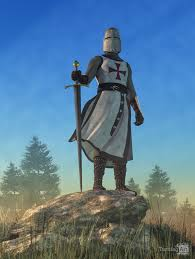Knights Templar history, a medieval order shrouded in mystery and legend, continues to captivate our imagination centuries after its dissolution. Who were these enigmatic warriors, and how did they become the subject of countless myths and conspiracy theories? Let’s dive deep into the world of the Templars, separating historical facts from fanciful fiction.
A Brief History of the Knights Templar
The Origins of the Order
The Knights Templar was founded in 1119 in Jerusalem by a group of nine knights led by Hugues de Payens. Their initial mission was to protect Christian pilgrims traveling to the Holy Land after the First Crusade. With the blessing of the Church, they took vows of poverty, chastity, and obedience.
The Rise to Power
In 1129, the Council of Troyes officially endorsed the order, granting it ecclesiastical support. Over the next two centuries, the Templars evolved from humble protectors into a powerful organization with vast wealth, influence, and military might. They established a network of fortresses across Europe and the Middle East and became a cornerstone of medieval banking, offering financial services that resembled modern systems.
The Fall of the Templars
By the late 13th century, the Templars faced declining support due to their wealth and political influence. King Philip IV of France, deeply in debt to the order, orchestrated their downfall. On Friday, October 13, 1307, Templar leaders were arrested on charges of heresy, blasphemy, and other fabricated crimes. The order was formally disbanded by Pope Clement V in 1312.
Unpacking the Myths
The Templars and the Holy Grail
One of the most enduring legends is the Knights Templar’s connection to the Holy Grail. Popularized by works like Dan Brown’s The Da Vinci Code, the theory suggests that the Templars guarded secret knowledge or relics, including the Grail. While intriguing, there’s no historical evidence to support this claim.

Hidden Treasure
The idea of Templar treasure buried in secret locations has fueled countless treasure hunts. Stories of hidden gold, artifacts, and sacred relics persist, but no concrete proof has ever been found. The most famous example is Oak Island in Nova Scotia, where treasure hunters have searched for centuries.
The Templar-Masonic Link
Freemasonry’s rituals and symbols have often been linked to the Templars. Some theories propose that the Templars survived their persecution by morphing into Freemasonry. However, historians argue that this connection is speculative and lacks direct evidence.
What Made the Templars Unique?
Military Innovation
The Templars were among the first to establish disciplined, professional military forces in medieval Europe. Their strategic use of fortifications, heavy cavalry, and disciplined ranks influenced later military tactics.
Financial Acumen
Beyond their military prowess, the Templars excelled in finance. They created an early system of checks and balances, allowing pilgrims to deposit money in one location and withdraw it elsewhere. This innovation laid the groundwork for modern banking.
Religious Devotion
As a religious order, the Templars’ spiritual dedication set them apart. They lived by the Rule of the Templars, a strict code influenced by the Rule of St. Benedict, emphasizing prayer, communal living, and martial readiness.
Fictional Depictions
In Literature
From Sir Walter Scott’s Ivanhoe to Umberto Eco’s Foucault’s Pendulum, the Knights Templar have been portrayed in various literary works, often as mysterious and morally ambiguous figures.
On Screen
Movies like Indiana Jones and the Last Crusade and series like Knightfall have cemented the Templars in pop culture, blending historical elements with dramatic storytelling.
The Modern Legacy of the Templars
Fraternal Organizations
Today, numerous groups claim a connection to the Knights Templar, including the Sovereign Military Order of the Temple of Jerusalem (OSMTH). While these groups honor Templar traditions, they are not direct descendants of the medieval order.
Influence on Popular Culture
The Templars’ mystique has made them a staple in video games, novels, and films. Their story continues to inspire intrigue, ensuring their place in the collective imagination.
Separating Fact from Fiction
Were the Templars Heretics?
The charges against the Templars, including heresy and blasphemy, were likely fabricated by King Philip IV. Modern historians agree that these accusations were politically motivated.
Did They Discover Hidden Knowledge?
The idea that the Templars unearthed secret knowledge or artifacts in Jerusalem lacks evidence. While they occupied the Temple Mount, no credible discoveries have been documented.
Is Friday the 13th Unlucky Because of Them?
The arrest of the Templars on October 13, 1307, is often cited as the origin of Friday the 13th’s bad luck. However, this connection is a modern interpretation and not rooted in medieval superstition.
What Can We Learn from the Templars?
Adaptability and Innovation
The Templars’ ability to adapt and innovate from military tactics to financial systems offers lessons in resilience and creativity.
The Power of Narrative
Their story illustrates how myths can shape collective memory, blending fact and fiction to create enduring legends.
Conclusion
The Knights Templar remain a fascinating blend of history and legend. While much of their story is rooted in fact, the myths that surround them ensure their enduring allure. Whether as pioneering warriors, financial innovators, or symbols of mystery, the Templars continue to capture the imagination of historians and storytellers alike.
FAQs About the Knights Templar
1. What was the primary mission of the Knights Templar?
Initially, the Knights Templar focused on protecting Christian pilgrims traveling to the Holy Land. Over time, their mission expanded to include military and financial roles.
2. Did the Knights Templar really have a secret treasure?
While stories of Templar treasure abound, no verifiable evidence of such a hoard has been discovered.
3. Are the Templars connected to Freemasonry?
Some theories suggest a link, but there is no direct historical evidence to confirm this connection.
4. Why were the Templars disbanded?
The Templars were disbanded due to political and financial pressures, primarily from King Philip IV of France, who sought to eliminate their influence and erase his debts.
5. Do any Templar organizations exist today?
Modern fraternal organizations, like the OSMTH, draw inspiration from Templar traditions but are not direct descendants of the medieval order.


